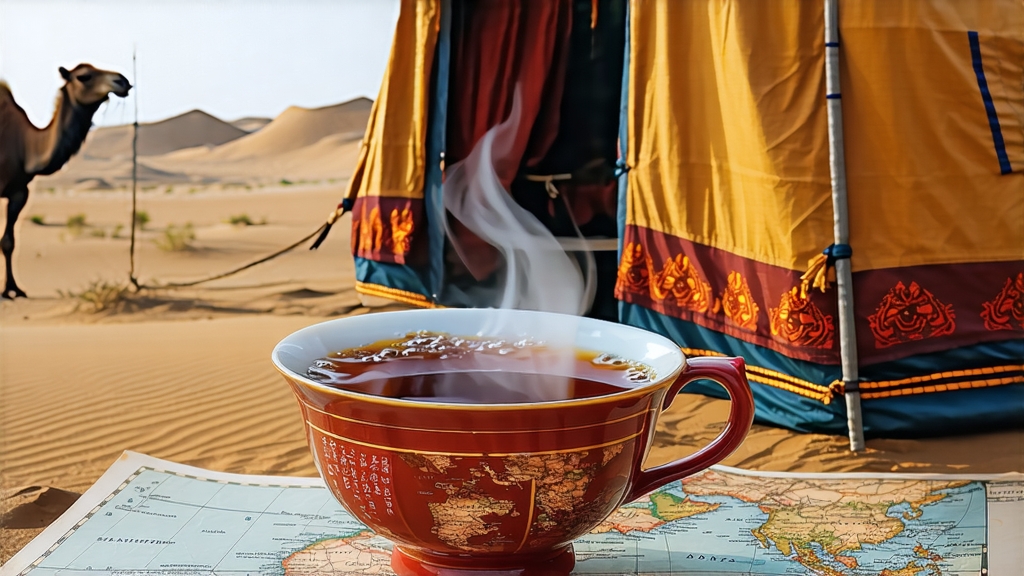
Few teas carry the romance of trans-Asian caravans as vividly as Fu brick tea. Compressed into dark, iron-hard blocks, scented faintly of earth and dried fruit, and freckled inside with tiny golden grains, Fu brick (often written “Fuzhuan”) is the poster-child of China’s post-fermented heicha family. To the uninitiated it looks like a relic; to the initiated it is liquid history, a beverage that literally improved with every jolt of a camel saddle. This article invites international tea lovers to discover why Fu brick was once tendered as currency along the Silk Road, how contemporary science is decoding its probiotic “golden flowers,” and how you can brew a cup whose mellow sweetness seems to echo the desert sunsets of five centuries ago.
-
Historical footprints
Fu brick first appeared during the Ming dynasty (1368-1644) in Jingyang county, Shaanxi province, a gateway between the tea-producing south and the horse-needing north. Imperial law at the time forbade the export of loose tea leaves to the nomadic peoples beyond the Great Wall, fearing military advantage if the leaves were used as barter for horses. ingenious merchants therefore invented a denser, more portable form: they steamed, piled, and pressed tea into bricks that could be stacked on camels, withstand months of temperature swings, and still taste invigorating when boiled in yak-butter. The bricks quickly became legal tender; one 1.5-kilogram Fu brick could reportedly buy a fine Mongolian stallion. By the Qing dynasty the court had institutionalized the trade through the “Tea-Horse Bureau,” and millions of bricks annually traveled westward, some reaching as far as Tsarist Russia. In 2008 the traditional skill of making Fu brick was inscribed on China’s National Intangible Cultural Heritage list, ensuring that the same microbial choreography that scented the caravans continues today. -
Terroir and leaf choice
Authentic Fu brick is still produced in a narrow latitudinal belt—Jingyang, Xianyang, and Cili counties—where the Wei River moderates humidity and the loess plateau stores mineral-rich groundwater. Producers select the large-leaf variety Camellia sinensis var. sinensis grown at 600–1,000 m in neighboring Hunan and Shaanxi. After the early-spring harvest the leaves undergo a rigorous grading: only the third and fourth mature leaves, plus a small portion of stems, are kept. These coarser tissues contain more cellulose and soluble sugars, the preferred substrate for Eurotium cristatum, the fungus responsible for the tea’s signature “golden flowers” (jin hua). -
Crafting the brick: a six-act play
Act 1 – Fixing (sha qing): The leaves are pan-fired at 280 °C for three minutes to inactivate most oxidative enzymes, yet residual PPO and POD survive, setting the stage for later microbial fermentation.
Act 2 – Rolling: A 25-minute light roll ruptures 35–40 % of the cells, enough to free amino acids without turning the leaf into powder.
Act 3 – Piling (wo dui): The semi-rolled leaves are heaped 70 cm high, sprayed to 28 % moisture, and covered with wet linen. Internal temperature climbs to 55 °C within 24 h; thermophilic bacteria and yeasts bloom, softening fibers and generating a fungal-friendly pH of 4.8.
Act 4 – Adding “flower seeds”: After 5–7 days the pile is broken up and inoculated with a starter culture rich in Eurotium cristatum spores. The inoculum is traditionally a powdered Fu brick from the previous year—an elegant example of back-slopping that predates modern microbiology.
Act 5 – Brick forming: 1.2 kg of fermented leaf is steamed for 30 seconds, then tipped into a pre-heated cedar mold. A hydraulic press exerts 50 MPa for six minutes, compacting the mass to a density of 1.1 g cm⁻³—tight enough to retard oxygen yet loose enough to allow fungal respiration.
Act 6 – Flowering & drying: The bricks are transferred to a 28 °C “flower room” held at 75 % RH. Over 12–18 days golden-yellow cleistothecia appear on the cut edges. Finally the bricks are moved to a 45 °C drying tunnel for 48 h, halting microbial growth while locking in the floral, chestnut-like aroma.